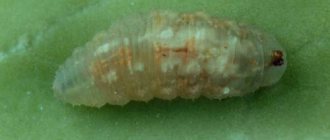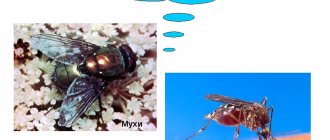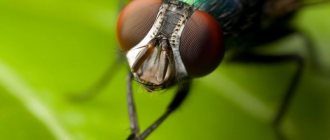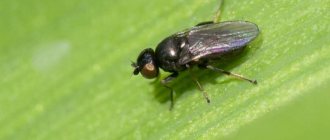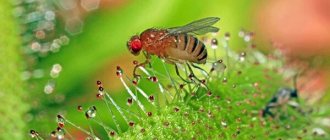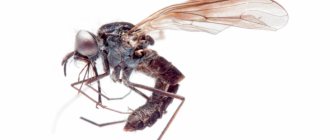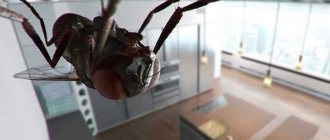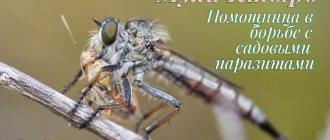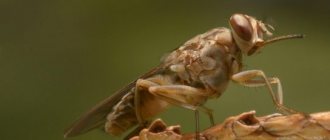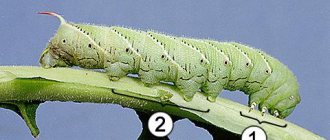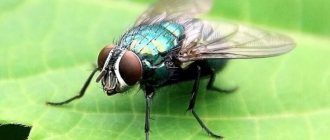With the onset of warmer weather, the problems of the ubiquitous flies return again. They penetrate everywhere and cause some discomfort to people. Natural dexterity, compound eyes that allow 360-degree vision, and many other features allow the insect to maintain its life and instantly respond to danger. The question of how a fly lands on the ceiling worries not only children, but also adults. For this purpose, nature has endowed it with some features.
Paw structure
The fly's foot ends in two claws and fine hairs, as well as glands that secrete an adhesive substance.
At first, scientists believed that the fly, thanks to its tiny claws and hairs, clings to the smallest irregularities or bulges, invisible to the human eye, on any surface. But with the development of science and microscopes, it turned out that special glands on the legs, similar to pads, help insects overcome the force of gravity. At one time, these pads were even considered suction cups.
Over time, it turned out that these were not suckers, but glands. A thousandfold magnification helped to see that they secrete a special sticky liquid in which fats and various sugars are mixed. It is this substance that gives flies the ability to literally stick to any surface, including the ceiling, and not fall. Research in this area is carried out by Stanislav Gorb from the German Max Planck Institute for Evolutionary Biology (Max-Planck-Institut für Entwicklungsbiologie) within the framework of the project “Biological Attachment Devices for Biomimetics”.
How does a fly come unstuck?
Everyone knows how difficult it is to catch a fly by surprise. If you swing it a little, it instantly takes off. With a jerk, strictly vertically, it will be very difficult for her to peel off the paw, so nature arranged it in such a way that the pad with the glands lags behind the surface gradually, in small sections. You can compare this to tearing off adhesive tape: if you pull the tape straight up along its entire length, it is almost impossible to tear it off, but gradually peeling the tape off from the surface is much easier. This happens in flies too.
In addition, two claws at the ends of the legs help the insect to peel off the pad after gluing it to the surface.
The secret of tenacious paws
Diptera insects, often found in people's homes, are able to crawl on any surface: walls, ceilings, glass, moving curtains. Scientists became interested in why the fly stays on the ceiling and does not fall even in a draft and wind. It was initially assumed that the reason for this was the presence of tenacious hooks on the insect’s legs. Most species of arthropods have such claws on their limbs.
Interesting!
A more detailed study of the structure of insects using modern microscopes has revealed new information to the world. At the tips of the clattering paws there are special glands that secrete a sticky liquid. It contains fat and sugar. This sticky mixture helps keep the fly balanced on the ceiling and prevent it from falling.
Fly on the ceiling
Slide captions:
Why doesn't a fly fall from the ceiling? Research work of student 2 “B” of class MBOU Secondary School No. 3 Anna Kostenkova
Research problem The weather has already turned to warmth. A house fly is crawling on the glass. Just woke up from her winter sleep, She begins a new life. We talk about flies without immediately thinking that a fly on its legs spreads infection. For some reason we don’t like flies from birth, and how easily we destroy defenseless flies.
Research problem These people are stupid! We don’t even know what good a fly can be. After all, flies don’t just sit on jam. They produce fertilizer for us. A fly can also bring healing. For birds, flies are a tasty treat. But here's what I don't understand about flies: How do flies stay on the ceiling? Problem! I decided to reveal this secret, to explore what I don’t know about.
Purpose of the study: Find out why the fly does not fall from the ceiling? Objectives of the study: To become familiar with the structure of a fly. - Observe her behavior. – Consider the experience of scientists on this topic. – Study additional material on the topic.
The hypothesis was not confirmed Observation of a fly The wings are motionless Perhaps these are wings? Wings do not help the fly stay on the surface
What if these are claws - hooks? The hypothesis was not confirmed. Holding with the help of claws - hooks is possible only on a rough surface, and not on a glossy one.
Could it be a sticky substance? Adhesive substance: a mixture of sugar and fat Pads - glands
Experience of British scientists Apply a liquid that removes fat Place the fly in a confined space Transfer the fly under a clean glass The fly has difficulty climbing onto a vertical surface
Conclusion 3 hypothesis was confirmed. The fly does not fall from the ceiling because the insect’s legs have tiny pads - glands that secrete droplets of a sticky substance consisting of a mixture of sugar and fat. And the claws help the fly to tear its leg off the surface after gluing.
Butterflies, of course, know nothing about snakes. But birds that hunt butterflies know about them. Birds that do not recognize snakes well are more likely to...
If octo is Latin for “eight,” then why does an octave contain seven notes?
An octave is the interval between the two closest sounds of the same name: do and do, re and re, etc. From the point of view of physics, the “relationship” of these...
Why are important people called august?
In 27 BC. e. Roman Emperor Octavian received the title Augustus, which in Latin means “sacred” (in honor of the same figure, by the way...
What do they write in space?
A famous joke goes: “NASA spent several million dollars to develop a special pen that could write in space….
Why is the basis of life carbon?
About 10 million organic (that is, carbon-based) molecules and only about 100 thousand inorganic molecules are known. In addition…
Why are quartz lamps blue?
Unlike ordinary glass, quartz glass allows ultraviolet light to pass through. In quartz lamps, the source of ultraviolet light is a gas discharge in mercury vapor. He…
Why does it sometimes rain and sometimes drizzle?
With a large temperature difference, powerful updrafts arise inside the cloud. Thanks to them, droplets can stay in the air for a long time and...
Why do you think a fly crawls on the ceiling and does not fall? How can this small insect perform such acrobatic feats?
It used to be thought that flies are helped by the finest hairs on their legs, with which they cling to the slightest irregularities on the surface of the ceiling. But when powerful microscopes appeared, thousandfold magnification showed that it was not the hairs, but tiny gland pads that secrete droplets of a sticky substance. Just enough glue is released so that the fly has enough strength to tear its leg off the surface when needed. Its small mass helps even a thin layer of substance to hold it.
Retention mechanism
At the beginning of the 20th century, entomologists believed that flies were held on surfaces with the help of miniature claws and hairs on their legs. Allegedly, they made it possible to cling to the slightest irregularities and stay on them. With the advent of modern electron microscopes, the true mechanisms of this process were revealed.
At the ends of insects' legs there are two pads called pulvilli. They are covered with thin bristles and pores that secrete a sticky substance consisting of fats and carbohydrates. The released secretion creates surface tension, temporarily keeping the creature from falling. If the fly moves to another place, it lifts its leg with an eversion to the side and, without making any effort, breaks the surface connection.
The household pest easily moves on all surfaces, except completely degreased ones. In the latter case, the fly cannot hold on and falls, after which it immediately uses its wings in parallel and flies to a more suitable area.
The role of the limbs
It should be noted that a fly needs legs not only to rest between flights or to walk. Amazing fact: each limb of this insect is equipped with taste buds! As soon as a fly lands on a particular object, it immediately determines the degree of its edibility.
Attention! In addition to taste, flies also have tactile receptors on their legs. The limbs perform several important functions at once, so flies carefully monitor their cleanliness.
How do flies wash themselves?
Flies do not wash themselves in the usual sense of the word. They clean their legs and wings frequently and thoroughly. Despite the fact that flies are carriers of many diseases and are considered one of the “dirtiest” creatures, they strictly observe the rules of personal hygiene.
Why do flies rub their legs?
Anyone who has ever observed the behavior of flies has noticed how often and diligently they rub their legs against each other. The fact is that while walking, the surface of the bristles becomes dirty. Small dust particles and other debris prevent full contact of the paws with the surface.
When a fly rubs its legs, it not only cleans them, but also stimulates the secretion of a sticky secretion. Thus, this simple action provides the insect with freedom of movement.
Virtuoso pilot
The chaotic movement of the front sight around the room is difficult to track. She lands on the ceiling from a loop or flip and immediately freezes in place. Just now the room was filled with its loud buzzing, and now there was silence.
Interesting!
Flies are perfectly oriented in space only in bright light. If it is turned down indoors, the insect may hit the wall or ceiling and fall.
During flight, when approaching any surface, the fly prepares to land and extends its limbs with Velcro at the ends. As soon as she is as close as possible to the obstacle, her glands securely fix her without causing injury. It can hang upside down or on a vertical surface for hours, and even in sleep the fly does not fall from the ceiling.
This method of grabbing onto any surface often saves the life of a fly. Not every predatory insect or other animal that hunted it is capable of maneuvering so deftly. But how does she tear her limbs off the ceiling if they are firmly glued? To do this, she uses a cunning method. To peel off the tip of a limb, she first peels off one side of the foot from the ceiling, then the other. This principle is familiar to everyone when peeling off tape.
What surface can it sit on?
The fly easily sticks to any surface. It can be horizontal, vertical, vertical. It does not slip even from glass and other smooth surfaces. If we consider the option of how a fly stays on a ceiling with wallpaper or other finishing, we can assume that the coating is imperfect.
For small insect legs, any, even very small, tubercle becomes an excellent way to gain a foothold. But it won’t even slide off the same surface, but made of perfectly smooth glass.
Why doesn't a fly fall from the ceiling?
Fly It is very easy to reveal this secret if you look at the structure of its legs through a microscope. A close-up shot will show the following features:
- Presence of 2 claws. They allow her to grab onto microscopic protrusions and hold on for a long time.
- Suckers. They are located at the base of the claws. The suction cup is made in the form of a small pad. On its outer side, the pads are overgrown with ordinary hairs; on the other side, the hairs have very small disc-shaped suckers.
- Sticky substance. At the end of the front legs, a special substance is released during landing. It's sticky and greasy. It is this that allows the individual to hang above the ground and not fall. Exactly enough sticky mixture is released so that it is enough to hold the individual, but not to impede its movement.
Interesting!
An interesting experiment was carried out by researchers. They laid special filter paper for the insects, which quickly and effectively absorbs any fat. As a result, the substance secreted by the flies was quickly absorbed, and the flies could not gain a foothold.
Experience “Magdeburg Hemispheres”
Cut out a rubber ring taking into account the internal and external diameters of the faceted glass and place it on the glass (instead, you can cut a ring from several layers of blotting paper and moisten it with water, then squeeze it lightly).
Set fire to a piece of paper, lower it into a glass and almost immediately cover it with a second glass and press it against the bottom one. After 1-2 seconds the fire will go out, lift the top glass, and the top one will rise behind it. Why? Historical reference. In 1654, Otto Guericke conducted an experiment in Magdeburg to prove the existence of atmospheric pressure. He pumped the air out of the cavity between the two metal hemispheres folded together. Atmospheric pressure pressed the hemispheres so tightly. that they could not be torn apart by eight pairs of horses pulling in two opposite directions.
How do flies land on the ceiling?
How do flies manage to walk on the ceiling without falling? How do they manage to land there? After all, flies fly with their backs up, which means they need to turn over. Maybe their paws are covered with some kind of magic glue that never dries? In fact, there is no glue on the fly's legs. N+1
Not only flies can land on the ceiling - this is one of the abilities of many insects. They are helped to cling to the ceiling by pulvillas - suction pads at the tip of their extendable legs that stick to the surface. Thanks to them, insects do not even have to completely turn their body over before landing on the ceiling. Some insects (such as the housefly Musca domestica
) make only a half turn, and “finish” the rest of the landing with your feet, sometimes taking an additional step or turning around the vertical axis. But the fruit fly does not rotate at all before landing on the ceiling - it turns out that it is enough for it to slow down.
Despite the fact that many features of insects landing on the ceiling have been described, not all methods of turning over are known, and those that are known have not been studied in too much detail.
American biophysicists led by Bo Cheng from the University of Pennsylvania have discovered that the planting process may be more complex than thought. With the help of a videographer, scientists carefully studied what maneuvers the black-headed blue fly (Calliphora vomitoria) makes when landing on the ceiling
) - the movement of the wings, legs and body position during the landing process were recorded. The authors of the work also monitored the visual stimuli to which the insect reacts - in particular, the speed at which the image of the approaching surface on the retina increases while moving upward, from which the animal can estimate the approximate time before a possible collision.
It turned out that this fly's landing on the ceiling occurs in four stages. First, the insect accelerates sharply upward, after which a body flip occurs (full or partial), then the animal stretches its legs and clings to the ceiling with them, and in the end it rotates its body relative to the legs, already rigidly attached to the surface. The entire process takes about 60 milliseconds and about 10 wing beats. The stage of the revolution itself takes from four to eight strokes with a frequency of about 170 Hertz.
In addition, scientists have identified several patterns during maneuvering. In particular, the lower the vertical speed during landing and the higher the horizontal speed, the less degree of inversion is needed for a successful landing. Interestingly, the degree of turn in fractions of unity approximately corresponds to the vertical speed in meters per second: if a fly slows down to 0.5 meters per second, then in order to land on the ceiling, it only needs to make half a turn, that is, turn 90 degrees.
In addition, biophysicists have determined that the signal for the start of a flip landing is the threshold value of the speed of increase in the image of the ceiling on the retina. Visual stimuli also determine the need for additional rotation of the body after landing and additional movements of the body and legs.
Atmospheric pressure and wildlife
The existence of an atmosphere makes life itself possible on Earth and has a significant impact on its nature. Thus, atmospheric oxygen is used in the process of respiration by living organisms; plants need carbon dioxide contained in the atmosphere. Without an atmosphere, the Earth would be a lifeless desert. There would be no blue sky overhead, because it is the atmosphere that scatters sunlight. There would be no seas and rivers, forests and wildlife. The surface of the Earth, like the surface of the Moon, would be dotted with craters, because... It is the atmosphere that protects our planet from the destructive effects of meteorites, most of which burn up before reaching the Earth’s surface. On Earth there would be no winds and rains, thunderstorms and sunsets, and there would be no medium in which sound could travel. The temperature during the day would exceed 130°C, and at night it would drop to -150°C.
Some birds easily tolerate areas of low atmospheric pressure and fly to high altitudes. The condor in the Andes rises to 9000 m, and nests at an altitude of 7000 m; mountain jackdaws on Everest rise to 8200 m, the vulture and hawk - to 6000-7000 m. Most birds do not rise above 4000 m.
Many living organisms (house flies, leeches, worms, fluke worms, octopuses, octopuses) have suction cups with which they can stick and attach themselves to any object: leeches move along the bottom of a reservoir, octopuses grab prey. At the same time, the suction cups increase in volume. A rarefied space is formed inside them, and external air pressure presses them against the object.
Atmospheric pressure allows animals, unlike humans, to freely pull their legs out of swampy soil. Under the leg, when a person lifts it, a rarefied space is formed and atmospheric pressure prevents the leg from being pulled out. In order to pull it out, a person must overcome not only the resistance of the soil, but also the force of atmospheric pressure. The horse has hard hooves like pistons. In pigs and ruminants, the hooves consist of several parts, and when the leg is pulled out, they compress due to the inequality of pressure above and below and allow air into the resulting depression. Therefore, there is no difference in air pressure above and below the hoof, and the leg rises easily.
Mystery experience
: How to remove a coin from under the water in a plate without getting your fingers wet or pouring the water out of the plate?
Interesting phenomena related to atmospheric pressure
: https://class-fizika.narod.ru/7_davlatm.htm
Soft landing: detailed analysis
Fly on the ceiling To give a better idea of how the landing occurs and why the fall does not occur, consideration of the behavior of the individual at the moment of landing will allow. During the flight, she easily performs various complex pirouettes, which allow her to securely attach to any materials.
Interesting!
The insect does not fly forward, like many others that fly, but backward. Therefore, to kill him, you should aim a little behind.
The fly lands on the ceiling from a loop or from a flip. As a result, it transfers the center of gravity to the front and sticks to the ceiling with its paws. The rest of the body catches up with the front part and seals the fly even tighter.
Prevention
To avoid the appearance of unwanted “guests”, it is necessary to maintain cleanliness in the house, especially in the kitchen: wet cleaning, timely emptying of the trash can, washing dishes, destroying spoiled food. Here are four more recommendations that will protect against the “invasion” of flies.
- Proper food storage. Store all food products either in the refrigerator or in a tightly closed container or tied plastic bag.
- Animal hygiene. Clean the cat's litter box or cage in a timely manner, as flies feed on excrement. Wash your pet's bowl daily.
- "Strengthening" windows. In the warm season, when windows and vents are constantly open, install mosquito nets to prevent insects from entering the apartment.
- Repellers. Add essential oils to the water for washing floors, periodically light aroma lamps, hang bunches of dried herbs, the smell of which flies do not like, plant geraniums.
In Ancient Egypt, dipterous insects were considered a symbol of courage and audacity, but now the buzzing arthropod creature personifies importunity. When thinking about how to deal with flies in an apartment, you need to take care of the safety of the methods used for households and pets.
Video on the topic
How to get rid of flies in the house - medical advice
